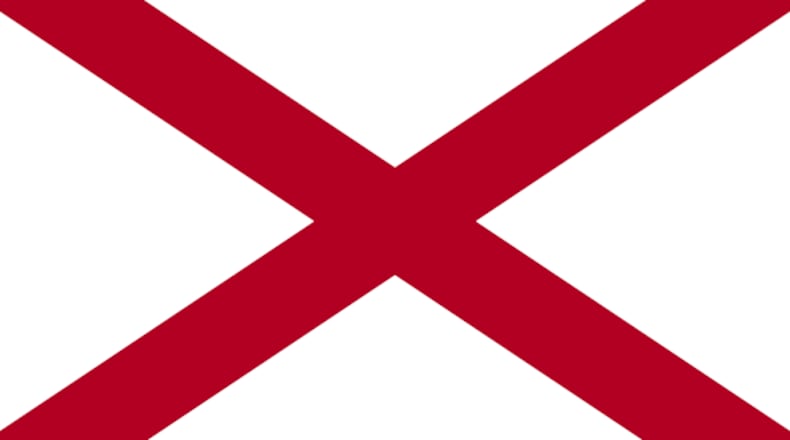- Niagara recalls bottled water over E. coli concerns
- Police officer sings to child ejected in deadly car accident
- Texas firefighter terminated over alleged Facebook post about Charleston massacre
- Cops got Burger King meal for Charleston shooting suspect after arrest
- Fashion victim? Health warning issued over skinny jeans after woman passes out
The prominent role of Confederate symbols — in flags, in state government materials, flown or displayed on state grounds — has again come under scrutiny in Southern states, following an apparently racially motivated massacare at a historic black church.
Texas has refused to sell license plates with the Confederate flag, and South Carolina's governor has called for the Confederate flag to be removed from capitol grounds.
Walmart and other retailers will no longer sell Confederate merchandise.
Here's a brief history of Confederate symbols, and controversies, in each Southern state.
Alabama
A Confederate flag no longer flies over the state capitol, as it did from 1961 to 1993. But the flags flew on state grounds as part of a Confederate memorial, until they were removed on Wednesday on order of the governor.
The state flag, adopted in 1895, features St. Andrew's Cross, which was also used in Confederate flags and which is linked to the Spanish Cross of Burgundy and which was used by the Spanish empire when colonizing North America.
A Sons of Confederate Veterans license plate, bearing the Confederate battle flag, is available for purchase in the state.
Arkansas
The state flag, adopted in 1924, features a diamond (Arkansas was the only state with a diamond mine) and a blue star above the state name, symbolizing its Confederate membership. The flag's symbolism was reaffirmed by then-Gov. Bill Clinton in 1987.
"It's part of history but, you know, it should not be utilized as a symbol for current events, it is history," Gov. Asa Hutchinson recently said about the Confederate flag.
Florida
Then-Gov. Jeb Bush had the "Stainless Banner," which was the Confederacy's second national flag and featured the original battle flag in the upper-left corner, quietly removed from Florida's capitol grounds in February 2001.
The decision was met with a flurry of angry emails, once some people realized what had happened. The flag was placed in a museum.
Its state flag was adopted in 1900 and features St. Andrew's Cross.
Georgia
A Confederate battle flag was featured on the state flag from 1956 to 2001. It was changed after mounting political pressure in the '90s and an unsuccessful attempt to remove it mounted by then-Gov. Zell Miller.
Click here to see a complete timline of the state's flags
The flag was changed from 2001 to 2003, incorporating many other state flags against a blue backdrop. But that flag was widely derided, and in 2003 Georgia adopted its newest flag, which closely resembles the original flag of the Confederacy, the Stars and Bars.
The state also sells a license plate submitted by the Sons of Confederate Veterans, which features the Confederate battle flag. Gov. Nathan Deal called this week for a redesign of the plates, backtracking on earlier comments that day.
Louisiana
The state flag was adopted in 2010, but is basically the same as the flag that has been flown since 1861, and features no Confederate symbolism.
In 2011, the state's Supreme Court said the Confederate flag was "offensive" to some, while reviewing a murder conviction in which a juror stated his reservations about the flag flying at a courthouse.
A Sons of Confederate Veterans license plate, bearing the Confederate battle flag, is available for purchase.
Mississippi
Mississippi's state flag is the only one in the South that incorporates a Confederate flag. And, according to the Clarion-Ledger, "Gov. Phil Bryant said Monday morning that he didn't expect the Legislature to 'supersede the will of the people on this issue,' " referring to a 2001 referendum in which a majority of citizens voted to continue using the flag, with its Confederate symbol, over a replacement.
The state flag was adopted in 1894; the previous flag did not use the Confederate battle flag.
A Sons of Confederate Veterans license plate, bearing the Confederate battle flag, is available for purchase.
North Carolina
The state flag has never incorporated the Confederate battle flag. However the color scheme of its state flag, adopted in 1885, echoes the flag it adopted in 1861, when it seceded from the Union: bars of red, white and blue.
Both flags also bore two dates — one of which was changed from the original date, May 20th, 1861 (the state's secession), to April 12, 1776: the day the state called for independence from Britain.
A Sons of Confederate Veterans license plate, bearing the Confederate battle flag, is available for purchase.
South Carolina
The Confederate battle flag still flies on South Carolina's capitol grounds where, by law, its removal requires the consent of the state legislature. Gov. Nikki Haley this week publicly called for the flag's removal from capitol grounds.
The state's flag has remained the same since 1861. And despite being the first state to declare secession, it bears no overt Confederate symbols.
A Sons of Confederate Veterans license plate, bearing the Confederate battle flag, is available for purchase in the state.
Tennessee
The state flag was adopted in 1905 and bears no Civil War links, though its blue bar may echo the "Blood-Stained Banner," the Confederacy's third national flag. In fact, the Tennessee flag's designer has said the bar "relieves the sameness of the crimson field and prevents the flag from showing too much crimson when hanging limp."
The renewed focus on Confederate regalia has led to a call to remove a bust from the statehouse of Nathan Bedford Forrest, a Confederate general and leader in the Ku Klux Klan.
A Sons of Confederate Veterans license plate, bearing the Confederate battle flag, is available for purchase in the state.
Texas
The state flag became official in 1933 but flew as the state flag after the Republic of Texas joined as a state in 1845. Texas flew the Confederacy's national flag during the Civil War; and the Bonne Blue flag bears a resemblance to the "Lone Star" which dominates the state flag now.
A recent Supreme Court decision upheld the state's refusal to sell specialty license plates bearing a Confederate flag.
Virginia
The state flag, adopted in 1950, has no resemblance to a Confederate flag; and neither did the flag the state flew following secession.
In recent years, the Confederate flag was removed from the Confederal memorial chapel at the Virginia Museum of Fine Arts and at the Lee Chapel, where Gen. Robert E. Lee is buried, at Lee University. This provoked a backlash from some, including a heritage group called the Virginia Flaggers, who planted a 660-square-foot Confederate flag on private land near I-95.
Gov. Terry McAuliffe announced this week that the state weould begin phasing out its own specialty license plates which bear a Confederate flag. His decision was prompted by a recent Supreme Court ruling that Texas could not be required to include an ideological message, the flag, on its license plates.
About the Author
The Latest
Featured

